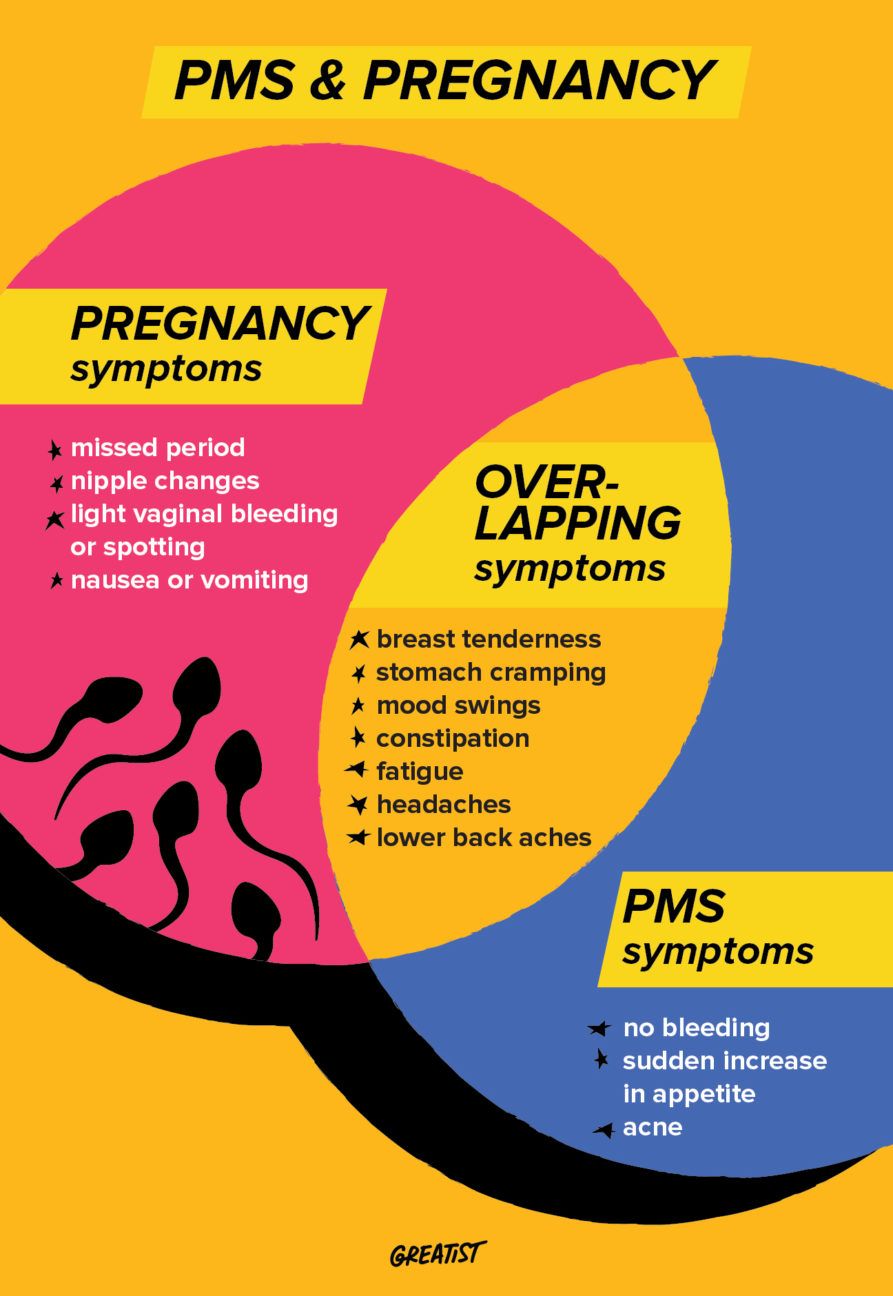Ah, the age-old question: “Is my period coming or am I pregnant?” It’s a question that’s prompted anxiety, anticipation, and excitement for generations of women the world over.
PMS, or premenstrual syndrome, refers to that less-than-lovely week or 2 before your period when rapid hormone fluctuations can get you down.
Short of a proper pregnancy test, navigating the difference between a raging case of PMS and early pregnancy can be tricky at best, especially when your period decides to make a fashionably late appearance.
Because female biology is a cruel mistress, it just so happens that your run-of-the-mill PMS symptoms can look and feel a mighty lot like those of early pregnancy. Let’s see how to spot (lol) the difference, shall we?
Fight club (moodiness)
PMS
Shedding your uterine lining is no walk in the proverbial park. Irritability is par for the PMS course, complete with crying spells and anxiety.
However, a sour mood tends to sweeten shortly after the period starts. If you suffer from monthly moodiness, exercising and getting plenty of sleep can help you feel less out of sorts.
Pregnancy
Pregnancy can throw a wrench in your emotional stability up until you give birth. However, unlike with PMS, your mood is likely to bounce all over the place. From bouts of crying to pure elation, carrying a child can be a real emotional rollercoaster.
Keep in mind that depression during pregnancy is common and ought to be treated. So, if you’re feeling extra down for long stretches, talk to your doctor about your options.
Everybody poops… except you!
PMS
If you feel a little less “regular” when you’re waiting for your period to show up, you can blame your hormones.
Higher than normal levels of progesterone in the latter half of your menstrual cycle have been known to cause digestive disturbances in the form of constipation.
Pregnancy
The hormonal changes associated with pregnancy may make it harder to go number two. Increased progesterone relaxes your intestinal muscles, which can slow things down in the pooping department.
Later on, as your uterus expands and puts pressure on your intestines, it may become even harder to — ahem — drop a different kid off at the pool.
Spot of doubt
PMS
Spotting or bleeding is not typical of PMS, but it doesn’t necessarily mean you’re pregnant. Underlying conditions including ovarian cysts or endometriosis can cause irregular bleeding.
As a rule of thumb, you should talk to your doctor about any bleeding that occurs outside of your normal menstrual cycle.
Pregnancy
Light vaginal bleeding can be one of the first signs of pregnancy. Pregnancy-related spotting is typically dark brown or light pink in color and occurs 10 to 14 days after conception. It usually lasts only a few days and is low in volume compared to a period.
Boobflation
PMS
Progesterone is a real pest, when it comes to PMS. Rising levels of this hormone have also been associated with swollen and/or tender breasts during the second half of your menstrual cycle.
Breast pain is likely to flare right before your period, and wear off as you start your period and your progesterone levels decrease.
Pregnancy
Pregnancy-related breast swelling and soreness tends to strike 1 to 2 weeks after you conceive. It can last as long as progesterone levels remain elevated as a result of your pregnancy.
If your breast pain feels out of sync with your period or lasts longer than normal, that’s as good an indication as any to take a pregnancy test.
Snoozeville
PMS
Feeling tired is a very common symptom of PMS, as is having a hard time sleeping. You can expect to get some pep back in your step once your period starts, but in the meantime exercising can help you catch up on any missed Zzz’s.
Pregnancy
Progesterone strikes again! And this time it’s in the bedroom. Increased levels of this pesky hormone during pregnancy can make you feel fatigued, especially during your first trimester.
Eating and sleeping as well as you can should help cushion the blow.
Cramp city
PMS
Did you know your PMS cramps have a fancy medical term? It’s called dysmenorrhea, but let’s just keep calling them cramps (it’s way easier).
Cramps are most likely to occur 24 to 48 hours before your period and eventually go away as your period comes to a close. The good news is that cramps tend to decrease as you age and after your first pregnancy.
However, you may have to deal with one final bout of them as you go into menopause.
Pregnancy
Mid to light cramping can happen early on in pregnancy. The pain is similar to menstrual cramps, but typically hits further south in your belly or in your lower back. It could also just be gas and constipation (see above).
Keep in mind that cramping during pregnancy can signal a pregnancy loss. If you have a history of miscarriages, pay special attention to your symptoms and talk to your doctor, especially if you experience watery discharge or bleeding.
A pain in the neck, back, and head!
PMS
Headaches and lower back pain like to turn up right before Aunt Flo. One study found that women with more inflammatory markers during their periods were most likely to experience back pain (not to mention cramps).
As far as your head is concerned, fluctuating levels of estrogen and progesterone before your period can trigger headaches, especially in women who have a history of migraines.
Pregnancy
Lower back pain is one of the most common complaints among pregnant women, especially in the early stages. The pain can range from dull to disabling and is brought on by hormonal changes.
Headaches during pregnancy are also very common. They too can be triggered by hormones, but if you’re indeed with child, something as insignificant as a bad smell could trigger one.
All the snacks and then some
PMS
Some clichés are devastatingly true — hell hath no fury on a refrigerator like a woman just before her period. It’s incredibly common for your eating habits to change before your monthly flow, and not for the better.
You may be absolutely ravenous, and for all the wrong things: chocolate, salty things, sugar, carbs… the works. Pregnancy doesn’t usually supercharge your cravings the way PMS can.
Pregnancy
Unlike PMS, pregnancy may make you crave strangely specific foods. Conversely, you may completely lose interest in others, including ones you used to love. Certain tastes and smells may totally turn you off. These sensory peccadillos can last your entire pregnancy.
If you find yourself craving things with no nutritional value, like dirt, ice chips, pieces of metal, or dried paint flakes, you may have a disorder called pica.
This disorder is typically seen in children, but can strike pregnant women as well. Definitely talk to your doctor if you feel the urge to eat your fork rather than the food on it.
Your period is MIA
A missed period is the hallmark sign of pregnancy. You know your cycle best, so if your cycles are a bit longer than the norm, this may not be cause for concern.
For the most accurate results, it’s best to wait 1 week after a missed period to whip out a pee stick (aka pregnancy test). This is because it takes your body 7 to 12 days after implantation to develop enough HGC (human chorionic gonadotropin) to produce a positive test result.
Not your average nipples
Another kind of wacky but surer sign of pregnancy is the way your nipples look. If you’re pregnant, they tend to stick out more and the areola around the nipple will appear larger.
During pregnancy, your nipples also darken due to hormonal fluctuations, and small glands called Montgomery’s tubercles may form raised bumps on the surface of your areolas. Your nipples know more than you’d think.
Nausea
While PMS may leave you feeling like a four letter word, nausea is a symptom typically reserved for the hormonal fluctuations associated with pregnancy.
Rising levels of HCG are mostly to blame. In fact, 70 to 80 percent of pregnant women experience nausea or vomiting, especially during the first trimester.
Makeover your habits
Certain lifestyle changes can greatly impact the severity of your PMS. Eating right (most of the time) and avoiding foods high in caffeine, sugar, and salt 2 weeks before your period is a good place to start.
Getting in some aerobic exercise and plenty of sleep is also key to maintaining your mood and energy levels. PMS can leave you feeling more stressed than usual, so don’t be afraid to #TreatYoSelf to a massage if it helps keep anxiety at bay.
Lastly (and for more reasons than PMS) don’t smoke — it makes PMS symptoms worse.
Get clinical
If lifestyle changes aren’t enough and your PMS feels unmanageable, it may be worthwhile to talk to your doctor about your symptoms.
You may have PMDD or premenstrual dysphoric disorder (more on that below), which can be treated with certain SSRIs (selective serotonin reuptake inhibitors).
Certain birth control pills containing drospirenone and ethinyl estradiol have also been approved by the FDA to treat PMDD.
PMDD is rather rare, affecting 3 to 8 percent of the population. Symptoms of PMDD are similar to those of PMS, except way more severe.
Women with PMDD may also experience panic attacks, depression, and thoughts of suicide. If your PMS feels way more intense than average, talk to your doctor.
Working yourself up won’t do you any favors, pregnant or otherwise. If your period is late or you’re feeling out of sorts, check in with yourself and if you need to, check in with your doctor.



